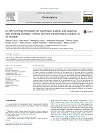A large number of anthropogenic trace contaminants such as pharmaceuticals, their human metabolites and further transformation products (TPs) enter wastewater treatment plants on a daily basis. A mixture of known, expected, and unknown molecules are discharged into the receiving aquatic environment because only partial elimination occurs for many of these chemicals during physical, biological and chemical treatment processes. In this study, an array of LC–MS methods from three collaborating laboratories was applied to detect and identify anthropogenic trace contaminants and their TPs in different waters. Starting with theoretical predictions of TPs, an efficient workflow using the combination of target, suspected-target and non-target strategies for the identification of these TPs in the environment was developed. These techniques and strategies were applied to study anti-hypertensive drugs from the sartan group (i.e., candesartan, eprosartan, irbesartan, olmesartan, and valsartan). Degradation experiments were performed in lab-scale wastewater treatment plants, and a screening workflow including an inter-laboratory approach was used for the identification of transformation products in the effluent samples. Subsequently, newly identified compounds were successfully analyzed in effluents of real wastewater treatment plants and river waters.
